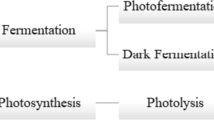Abstract
Cultures of Acetobacterium woodii and Clostridium thermoaceticum growing on fructose or glucose, respectively, were found to produce small, but significant amounts of carbon monoxide. In the gas phase of the cultures up to 53 ppm CO were determined. The carbon monoxide production was completely inhibited by 1 mM cyanide. Cultures and cell suspensions of both acetogens incorporated 14CO specifically into the carboxyl group of acetate. This CO fixation into C1 of acetate was unaffected by cyanide (1 mM). The findings are taken to indicate that CO (in a bound form) is the physiological precursor of the C1 of acetate in acetate synthesis from CO2. The cyanide inhibition experiments support the hypothesis that the cyanide-sensitive carbon monoxide dehydrogenase may serve to reduce CO2 to CO rather than to incorporate the carbonyl into C1 of acetate.
Similar content being viewed by others
References
Clark JE, Ragsdale SW, Ljungdahl LG, Wiegel J (1982) Levels of enzymes involved in the synthesis of acetate from CO2 in Clostridium thermoautotrophicum. J Bacteriol 151:507–509
Conrad R, Thauer RK (1983) Carbon monoxide production by Methanobacterium thermoautotrophicum. FEMS Microbiol Lett 20:229–232
Diekert G, Ritter M (1982) Nickel requirement of Acetobacterium woodii. J Bacteriol 151:1043–1045
Diekert G, Ritter M (1983) Carbon monoxide fixation into the carboxyl group of acetate during growth of Acetobacterium woodii on H2 and CO2. FEMS Microbiol Lett 17:299–302
Diekert GB, Thauer RK (1978) Carbon monoxide oxidation by Clostridium thermoaceticum and Clostridium formicoaceticum. J Bacteriol 136:597–606
Dorn M, Andreesen JR, Gottschalk G (1978) Fumarate reductase of Clostridium formicoaceticum. Arch Microbiol 119:7–11
Eden G, Fuchs G (1982) Total synthesis of acetyl coenzyme A involved in autotrophic CO2 fixation in Acetobacterium woodii. Arch Microbiol 133:66–74
Fuchs G, Stupperich E (1980) Acetyl CoA, a cetral intermediate of autotrophic CO2 fixation in Methanobacterium thermoautotrophicum. Arch Microbiol 127:267–272
Hu SI, Drake HL, Wood HG (1982) Synthesis of acetyl coenzyme A from carbon monoxide, methyltetrahydrofolate, and coenzyme A by enzymes from Clostridium thermoaceticum. J Bacteriol 149:440–448
Kearny JJ, Sagers RD (1972) Formate dehydrogenase from Clostridium acidiurici. J Bacteriol 109:152–161
Lang E, Lang H (1972) Spezilische Farbrealtion zum direkten Nachweis der Ameisensäure. Z Anal Chem 260:8–10
Lynd L, Kerby R, Zeikus JG (1982) Carbon monoxide metabolism of the methylotrophic acidogen Butyribacterium methylotrophicum. J Bacteriol 149:255–263
Mullen A (1980) Carbonylations catalyzed by metal carbonyls — Reppe reactions. In: Falbe J (ed) New syntheses with carbon monoxide. Springer, Berlin Heidelberg New York, pp 286–290
Passonneau JV, Lowry OH (1970) Pyruvat — Fluorimetrische Bestimmung. In: Bergmeyer HU (ed) Methoden der enzymatischen Analyse, 2nd ed, vol II. Verlag Chemie, Weinheim, pp 1412–1416
Schulman M, Ghambeer RK, Ljungdahl LG, Wood HG (1973) Total synthesis of acetate from CO2. VII. Evidence with Clostridium thermoaceticum that the carboxyl of acetate is derived from the carboxyl of pyruvate by transcarboxylation and not by fixation of CO2. J Biol Chem 248:6255–6261
Seiler W, Giehl H, Roggendorf P (1980) Detection of carbon monoxide and hydrogen by conversion of mercury oxide to mercury vapor. Atmos Technol 12:40–45
Sharak-Genthner BR, Bryant MP (1982) Growth of Eubacterium limosum with carbon monoxide as the energy source. Appl Environ Microbiol 43:70–174
Simon H, Floss HG (1967) Bestimmung der Isotopenverteilung in markierten Verbindungen. Springer, Berlin Heidelberg New York, pp 23–27
Stupperich E, Fuchs G (1983) Autotrophic acetyl coenzyme A synthesis in vitro from two CO2 in Methanobacterium. FEBS Lett 156:345–348
Stupperich E, Hammel KE, Fuchs G, Thauer RK (1983) Carbon monoxide fixation into the carboxyl group of acetyl coenzyme A during autotrophic growth of Methanobacterium. FEBS Lett 152:21–23
Thauer RK, Jungermann K, Decker K (1977) Energy conservation in chemotrophic anaerobic bacteria. Bacteriol Rev 41:100–180
Wood HG, Drake HL, Hu SI (1982) Studies with Clostridium thermoaceticum and the resolution of the pathway used by acetogenic bacteria that grow on carbon monoxide or carbon dioxide and hydrogen. Proc Biochem Symp, Ann Rev Inc, pp 29–56
Author information
Authors and Affiliations
Rights and permissions
About this article
Cite this article
Diekert, G., Hansch, M. & Conrad, R. Acetate synthesis from 2 CO2 in acetogenic bacteria: is carbon monoxide an intermediate?. Arch. Microbiol. 138, 224–228 (1984). https://doi.org/10.1007/BF00402125
Received:
Accepted:
Issue Date:
DOI: https://doi.org/10.1007/BF00402125




